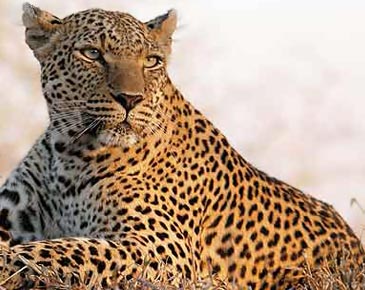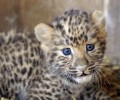Leopard
Facts about leopards | All about Leopards | Leopard photos
Leopard is a member of the cat family and is the smallest amongst the 'Big Cats'; other big cats being – Lion, Tiger and Jaguar. Leopard is well known for its camouflage and stealth. This is because of its body, which is covered with spots and its agility owing to flexible muscles. Leopard is the most cunning amongst the ‘Big Cats’ as it can adapt to varying environments with quite ease. It is also the most successful of all the big cats because of their adaptability. Their adaptability has helped them survive the loss of habitat caused by increasing human settlement. This has also made them the most widespread one as well.
- Leopard 9 Subspecies
- Leopard Information
- Leopard's Physical Characteristics
- Black Leopards
- Leopard Distribution
- Leopard Behaviour
- Leopard Prey
- Leopard Reproduction
- Zanzibar Leopard
There are 9 Subspecies of Leopard recognised by International Union for Conservation of Nature (IUCN)
- African leopard - Found in sub-saharan Africa.
- Amur leopard - Found in the Russian Far East, Korean Peninsula and Northeast China.
- Arabian leopard - Found in the Arabian Peninsula.
- Indian leopard – Found in India.
- Indochinese leopard – Found in mainland Southeast Asia
- Javan leopard – Found in Java, Indonesia.
- North Chinese leopard - Found in northern China.
- Persian leopard (Caucasian leopard) – Found in central Asia: the Caucasus, Turkmenistan and northern Iran.
- Sri Lankan leopard – Found in Sri Lanka.
Leopard Facts
|
Leopard can run at over 58 kilometres per hour (36 mph). |
|
It can leap over 6 metres (20 ft) horizontally and jump up to 3 metres (9.8 ft) vertically. |
|
A leopard can even hunt even in trees; catching a monkey or a bird. |
|
A leopard can carry dead weight about 2–3 times its own weight up to 5.7 m (19 ft) into a tree. |
|
No two leopards have the same markings or colour. In fact each leopard's spots are unique, similar to human fingerprints. |
|
A leopard’s vision at night is considered to be six times better than a human’s eyesight. |
|
10 day old cubs have light blue coloured eyes which changes to greenish-golden by the time, they are about 4 months old. |
|
Leopards can reach 21 years of age in captivity |
|
At an average leopard consumes 3.5 kg (7.7 lb) of meat for adult males and 2.8 kg (6.2 lb) for females. |
|
A leopard swallows pieces of meat without chewing. |
|
Arabian leopard is the shortest leopard subspecies; adult females weigh as little as 20 kg (44 lb). |
All about Leopards
Scientific Classification
- Kingdom - Animalia
- Phylum - Chordata
- Class - Mammalia
- Order - Carnivora
- Family - Felidae
- Genus - Panthera
- Species - Panthera pardus (binomial/ scientific name)
Leopards generally have a tawny coat (brownish orange colour) with black spots. These distinctive dark spots are called rosettes because they resemble the shape of a rose. The fur under the belly tends to be lighter coloured and of a softer, downy type.
The leopard’s claws are about 1 inch (2.5 centimetres) long. These are retractable, needle-sharp and curved. The claws are retractable which are used for fighting, holding prey and for scratching tree trunks to mark their territory. Their claws remain inside the paw while walking; this prevents wear and tear and also helps them avoid injury. The retraction helps them to approach their prey without any sound.
A leopard has 32 teeth, which are of 3 types – canine teeth, carnassial teeth (molars), and incisors. Canines are the four long and pointed teeth on either side of a leopard’s mouth. These are about 2 inches (5 centimeters) long. Canine teeth are used mainly for biting and piercing.
Carnassial teeth are the teeth located along the sides of its jaws. These have extremely sharp edges and they help in cutting pieces of meat. Incisors are the small upper and lower front teeth. These are used to strip off the prey’s fur, nibble small bits of meat from prey’s bones and provide more gripping power to the jaws.
Leopards have greenish-golden, oval-shaped eyes.
Face, limbs and underbelly are covered with solid black spots instead of open rosettes. There is however, lot of variety in coat colour and rosette patterns depending upon the climate and habitat type. Asian population have large squarer rosettes than African ones. Those living in deserts have pale and cream coloured coat, those residing in colder climates are more greyish and those found in rainforests have a dark golden coat.
Leopards have a long body with relatively short legs. They have large skulls that facilitate powerful jaw muscles and enable them to take large prey. The muscles attached to the scapula (shoulder bones) are exceptionally strong, which enhance their ability to climb trees.
Because of their spots they are generally confused with Cheetah and Jaguar. Cheetahs have simple black round spots which are evenly shaped. Jaguars have small spots inside the polygonal rosettes. Cheetah is also slim in built and Jaguar is bulkier in appearance.
However, the patterns of spots in each are different: the cheetah has simple black spots, evenly spread; the jaguar has small spots inside the polygonal rosettes.
Some Leopards are completely black with barely visible spots. Such leopards are called ‘Panthers’ or ‘Black Leopard’. The black colour is caused by high amount of pigment or melanistic coloration. Melanistic coloration or Melanism happens because of a recessive gene mutation of the leopard which is hereditary. It isn’t necessary that a black leopard will have a black offspring, a normal coloured leopard may have a black offspring and vice versa. However, if both parents are black, the leopard cubs will also be black.
Black leopards are most commonly found in the tropical rainforests of South and Southeast Asia and tropical rainforest on the slopes of some African mountains such as Mount Kenya
The dark coloration provides them better camouflage in the dark environs of a rainforest. Melanism is considered as a beneficial evolutionary mutation in the immune system of leopards.
Weight - Males are about 30% larger than females, weighing 30 to 91 kg (66 to 200 lb) compared to 23 to 60 kg (51 to 130 lb) for females.
Height - Head and body length is between 95 and 165 cm (37 and 65 in), and the tail reaches 60 to 110 cm (24 to 43 in). Shoulder height is 45 to 80 cm (18 to 31 in).
Geographical Range and Habitat
Leopard’s habitat ranges from rainforest to desert terrains. It is mostly found in sub-Saharan Africa, parts of the Indian subcontinent, Sri Lanka, Indochina, Malaysia, Indonesia, and China.
Leopards are Solitary creatures. They do not live in a group. They are nocturnal i.e. they are the most active during the night. But depending upon their environment and availability of prey, they can be active even during the day. Leopards found in forests show seasonal differences in activity patterns. They are good climbers and can climb any tree with ease. They often rest on trees during the day and even eat their prey on tree as well.
Leopards are territorial and each individual has his own specific area. Any other leopard is not welcome in their territory. Male leopards tend to have large home range than females. Territories rarely overlap amongst the males but amongst male and female territories, overlapping is common. If there is overlapping amongst males, violent encounters are inevitable with occasional duels ending in injuries and or even subsequent death.
They stalk their prey silently. They will pounce only when they are at a comfortable distance. They will crouch in the cover and just at the last minute will launch a full-fledged attack. They suffocate their prey to death by holding on to the prey’s neck. They drag the bodies of their prey on the tree to keep it safe from other predators like hyenas and lions.
Leopards are very intelligent hunters. Sometimes while hunting, they will purposely produce a cracking with their paws. By doing so, they create chaos amongst their prey to find out which is the weakest or easy individual to catch.
Leopards are not born man-eaters. It is only old aged, sick or injured leopards that may happen to hunt humans. While not all will hunt humans, they will kill dogs, pigs, sheep’s, fowl and any other domesticated animal. Healthy leopards avoid humans and stick to their natural prey.
Leopards are opportunistic feeders and hunters. If they find a weaker predator with a prey, they will scare them away and eat their kill. They often drive cheetahs away from their prey. They will even hunt unconventional prey like young giraffes, young crocodiles or any prey of manageable size.
Leopards will kill and sometime even consume offspring of other predators if they get the opportunity. Lion, hyena and cheetah cubs are the most susceptible. They do this to reduce the prey competition, simple enmity or extreme hunger.
Leopards will often scratch their claws on a rough surface, like a tree trunk to keep them sharp. They also do this to mark their territory. They also urinate on bushes to mark the territory. They are able to verify each other’s location from these markings and their low, rasping calls.
They are constantly on the move within their range and never spend more than a few days in one spot.
Leopards are not fussy eaters. They hunt a wide variety of prey which includes small birds to large antelopes. Hunting preference varies from subspecies to subspecies and is dependent on prey availability. They are opportunistic hunters and will even eat rodents, reptiles, amphibians, insects of manageable size. Their most common prey are ungulates (hoofed mammals) and monkeys. The weight of their prey ranges from 20 to 80 kg (44 to 180 lb).
Their Prey list includes:
Bat-eared fox, Bamboo rat, Bushbuck, Baboons, Chital (spotted deer), Common duiker, Eland, Hare, Hyrax, Ibex, Impala, Jackal, Marten, Muntjac, Thomson's gazelle, Tufted deer, Vulturine guineafowl, Warthog, Wild Boar, Zebra etc.
Reproduction
Leopards reach sexual maturity at the age of 2. They don’t have any specific mating period. In tropical areas breeding takes place all year round but it is seasonal in the savannahs.
The estrous cycle of a female lasts about 46 days and she is in heat for 6–7 days. When a female leopard is on heat (ready to mate), it attracts males by the smell of her urine. Any leopard that happens to get the scent of her urine will search for her. And if there is no other male around, he will mate with her repeatedly for several days. If there is another male, a fight takes place to decide who will mate.
During the mating period, male and female may stay together and will even share food. Once the mating period is over the male goes his way without any responsibility for rearing the cub.
Gestation of a leopard lasts for 90 to 105 days. They usually give birth to 2 or 4 cubs. The female gives birth in a cave, crevice among boulders, hollow tree, or thicket to make a den. Cubs are born with closed eyes, which open four to nine days after birth. They have garyish coat with faded spots. Cubs live with their mothers for about 18–24 months.
The Zanzibar Leopard (Panthera pardus adersi) is an extinct subspecies of leopard. It was found in Unguja Island in the Zanzibar archipelago (Tanzania). Leopard killing campaigns owing to superstitions, habitat loss of both the leopard and its prey were responsible for its extinction. It was smaller in size than the African leopard and had spots instead of rosettes. It was declared extinct in 2012.





